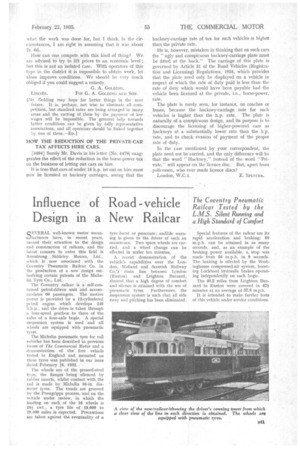Influence of Road -vehicle Design in a New Railcar
Page 59

If you've noticed an error in this article please click here to report it so we can fix it.
The Coventry Pneumatic Railcar Tested by the L.M.S. Silent Running and a High Standard of Comfort QEVER_AL well-known motor manu facturers have, in recent years, turned their attention to the design and construction of railcars, and the latest concern to enter this field is Armstrong Siddeley Motors, Ltd.. which is now associated . with the Coventry Pneumatic Railcar Co. in. the production of a new design embodying certain patents of 'the Michelin Tyre Co., Ltd.
The Coventry railcar is a self-contained petrol-driven unit and accommodates 60 passengers. The motive power is provided by a 12-cylinderecl petrol engine which develops 240 b.h.p., and the drive is taken through a four-speed gearbox to three of the. axles of a four-axle bogie. A special suspension system is used and all wheels are equipped with pneumatic tyres.
The Michelin pneumatic tyre for rail vehicles has been described • in previous issues of The Commercial Motor and a demonstration of the first vehicle tested in England and mounted on these tyres was published in our issue dated February 16, 1932.
The wheels are of the pressed-steel type, the flanges' being silenced by rubber inserts, whilst contact with the rail is made by Michelin 36-in, diameter tyres. The. treads are grooved by the Pneugrippa process, and on the vehicle under review, in which the loading on each of the 16 wheels is 16,i cwt., a tyre life of 15,000 to 20,000 miles is expected. Precautions are taken against the eventuality of a
tyre burst or puncture; audible warning is given to the driver of such an occurrence. Two spare wheels are carried, and a wheel change can be effected in under ten minutes.
A recent demonstration of the vehicle's capabilities over the London,. Midland and Scottish Railway Co.'s main line between London (Ruston) and Leighton Buzzard, showed that a high degree of comfort and silence is attained with the use of pneumatic tyres: Furtherniore, the suspension system is such that all side sway and pitching has been eliminated.
Special features of the railcar are its rapid acceleration and braking; 50 m.p.h. can be attained in as many seconds, and, as an example of the braking power available, a stop was made from 56 m.p.h. in 9 seconds. The braking is effected by the Westinghouse compressed-air system, boosting Lockheed hydraulic brakes operating independently on each bogie.
The 40.2 miles from Leighton Buzzard to Ruston were covered in 421 minutes at an average of 57.8 m.p.h.
It is intended to make further tests of this vehicle under service conditions.




































































































